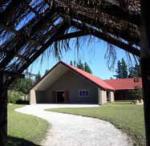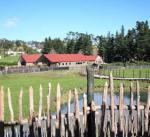Te Hana Te Ao Marama
The opening of an educational and cultural tourist village in Te Hana as signalled a new dawn for what was once a community in crisis.
In fact, such were Te Hana’s problems with poor housing, crime and a polluted water supply that authorities wanted to close down the town, which is just north of Wellsford on SH1 and on the border of the Auckland and Northland regions.
In 2002, concerned local iwi and community members formed the Te Hana Community Development Charitable Trust to turn things around.The Trust’s CEO, local architect Linda Clapham, recalls that they were trying to resurrect “an imploding community” with problems such as high unemployment, vandalism, poor literacy and drug and alcohol dependency. They came up with a plan to build an educational marae and cultural tourist village to provide inspiration and employment for the people of Ngati Whatua ki Kaipara. Throughout the process, Linda says the trust has been guided by elders on matters of tikanga (protocol).
“We started off with nothing but a dream,” says Linda. “We had no land, no money but we just thought there must be a better way for our community and for our young ones.”
A major breakthrough was convincing the Rodney District Council to upgrade the town’s water and sewerage systems, which had been causing residents health problems.
To fulfil their vision, the trust needed land for the project and it was able to get a recreational reserve beside SH1 that was being grazed by cattle reclassified to a special purposes reserve, for which they were granted a 99-year lease.
Linda, who has an architecture practice in Wellsford, came up with the design for the ambitious project that the trust hoped would help address unemployment in Te Hana which was running at 20 per cent, as well as wider social issues.
“In the old days when we had the dairy factory, forestry and the railways there were plenty of jobs but those have pretty much disappeared,” says Linda. “When the dairy factory closed down in the 70s that left a huge hole.” Discontent in the community manifested itself in problems with arson, graffiti and kids throwing rocks at cars passing on SH1. With not much money to begin with, the trust focused on cleaning up and replanting the nearby river bank and landscaping the site. “Before we got started, anyone from here doing community service work was doing it down in Glenfield,” says Linda. “But we talked to the Department of Corrections and got the workers into the riverbank clearing gorse and blackberry.”
Construction work began in November 2007 and over the years two buildings shifted on to the site have been converted to become the wharenohanga (sleeping house) and whare kai (dining room).
The whare kai used to be a fishing lodge on Kawau Island, which was barged across in three pieces before being reassembled and altered to give it a more traditional look. Likewise, the wharenohanga used to be a Salvation Army building that was shifted from Snells Beach. The roofline of the whare kai was altered to give it a traditional gabled look and all buildings, including the new wharenui (meeting house) were roofed in Colorcote ZR8 Corrugate, with the Scoria colour also reinforcing the traditional look.
The whare kai (named Matariki) can cater for 200 guests and also has a café that opens to a north-facing deck that can cater for 40 people. The café can be shut off from the main dining room and has its own entrance so casual visitors don’t disturb guests who are being hosted at the village. There is an adjoining whare paku (toilet and shower block) for guests, with the women’s facilities having a specially made mother-of-pearl inlay around the mirrors, while the mirrors in the men’s area are edged with a paua shell inlay.
The wharenui can sleep up to 50 people and has LED lights embedded in its ceiling to represent a starscape (in keeping with the name of the wharenui – Nga Whetu o te Rangi, or ‘Stars of the Universe’).
Projectors on either side of the wharenui will be used to create a night sky on the ceiling. “The idea is that you put the mattresses out on the floor and lie down in the evening and this will be part of storytelling about the constellations,” says Linda.
Across from the whare kai is a replica 17th century Maori village that is accessed via a winding boardwalk with a nikau frond roof. “This boardwalk represents the transition between the contemporary world and the ancient world,” says Linda.
The gateway to the village is a collection of small caves – recycled from an award-winning display at the Ellerlise Flower Show – which has a waterfall tumbling down over top and an LED water feature inside. The creation of the caves has been led by Clyde Tukaiora Connell, a landscape designer and contractor, and a team of local rangitahi (youths).
The village has raupo whare, manuka palisades and 9m-high watchtowers (pourewa) that can be lit up. At the centre of the village is a stage for performances and a seating area for guests that will eventually be covered by a tensile canvas canopy.
Linda says the idea behind the project is that guests will be welcomed on to the Te Ao Marama Marae with traditional powhiri before enjoying food and kapa haka entertainment and a tour of the village. The marae will provide accommodation as well as a cultural experience and already has bookings from school groups. Linda says it would also host tour groups and could also be used for seminars or conferences.
The replica village has a watercourse running in front of it so there is also potential for guests to arrive there by waka.
Local kaumatua Ben Hita, people from the local community and several Department of Corrections
teams are responsible for creating the village and have planted thousands of native trees and shrubs in this area.
Beyond the village, towards the river bank, is a pou (carved totem pole) depicting the 17th century legend of Princess Te Hana (after whom Te Hana is named), who fell in love with a warrior from another tribe with tragic consequences.
Plans are under way for a visitor centre towards the roadside off the boardwalk and a carving and weaving studio on the other side of the boardwalk. Currently, carving and weaving is done in a building that is fronted by the Ahi Kaa Gallery beside SH1. This building also houses Kaipara FM, a radio station with a broadcast range of about 8km that encourages local youth to get involved. Building Te Ao Marama has provided plenty of work and training for locals but when it is fully up and running Linda says it will create about 250 jobs as well as providing an outlet for performing arts and traditional crafts such as carving and weaving.
“The young ones are right into it; they become so animated with the performing arts and the radio station,” says Linda. “There is so much creativity and talent among them but there’s been no platform for them.”
Linda says she and trust chairman Thomas de Thierry have basically forsaken their careers to push the project through in the past 10 years. “It’s been a lot of work not only on the physical buildings but also providing tertiary education and employment opportunities,” says Linda.
Community fund raisers have helped to finance the project as have grants from the ASB Community Trust and NZ Lotteries, and money from an anonymous donor.
Linda is particularly proud of the fact that the marae has a Qualmark rating and an Enviro Award but adds, “There’s no point this being a fivestar facility if you don’t address the social issues.”
With that in mind, the trust has successfully lobbied for Te Hana to be included in the Auckland region’s Long Term Council Community Plan (LTCCP) and wants it to be recognised as the gateway between Auckland and Northland.
“It’s important to be in the LTCCP because that means you have access to funding that can create the outcomes,” says Linda. “And with something like 4.5 million cars coming through here each year it would be great to be recognised as the gateway. We’re very proactive on those fronts.”
With its strategic location on SH1, Linda expects Te Hana Te Ao Marama will be a magnet for domestic and overseas tourists who are curious about Maori culture. “Little old Te Hana will be on a national stage and on an international stage and that speaks volumes for the power of architecture.”
Architecture North Architect Linda Clapham’s practice is in Wellsford and she is an honours graduate of the University of Auckland School of Architecture.





